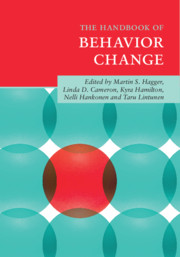Book contents
- The Handbook of Behavior Change
- The Handbook of Behavior Change
- Copyright page
- Dedication
- Contents
- Figures
- Tables
- Sidebars
- Contributors
- 1 Changing Behavior: A Theory- and Evidence-Based Approach
- Part I Theory and Behavior Change
- 2 Changing Behavior Using the Theory of Planned Behavior
- 3 Changing Behavior Using Social Cognitive Theory
- 4 Changing Behavior Using the Health Belief Model and Protection Motivation Theory
- 5 Changing Behavior Using the Common-Sense Model of Self-Regulation
- 6 Changing Behavior Using the Model of Action Phases
- 7 Changing Behavior Using the Health Action Process Approach
- 8 Changing Behavior Using Self-Determination Theory
- 9 Changing Behavior Using Control Theory
- 10 Changing Behavior Using the Transtheoretical Model
- 11 Changing Behavior Using Integrative Self-Control Theory
- 12 Changing Behavior Using the Reflective-Impulsive Model
- 13 Changing Behavior Using Habit Theory
- 14 Changing Behavior by Changing Environments
- 15 Changing Behavior Using Integrated Theories
- 16 Changing Behavior Using Social Identity Processes
- 17 Changing Behavior Using Ecological Models
- 18 Changing Behavior Using Theories at the Interpersonal, Organizational, Community, and Societal Levels
- Part II Methods and Processes of Behavior Change: Intervention Development, Application, and Translation
- Part III Behavior Change Interventions: Practical Guides to Behavior Change
- Index
- References
2 - Changing Behavior Using the Theory of Planned Behavior
from Part I - Theory and Behavior Change
Published online by Cambridge University Press: 04 July 2020
- The Handbook of Behavior Change
- The Handbook of Behavior Change
- Copyright page
- Dedication
- Contents
- Figures
- Tables
- Sidebars
- Contributors
- 1 Changing Behavior: A Theory- and Evidence-Based Approach
- Part I Theory and Behavior Change
- 2 Changing Behavior Using the Theory of Planned Behavior
- 3 Changing Behavior Using Social Cognitive Theory
- 4 Changing Behavior Using the Health Belief Model and Protection Motivation Theory
- 5 Changing Behavior Using the Common-Sense Model of Self-Regulation
- 6 Changing Behavior Using the Model of Action Phases
- 7 Changing Behavior Using the Health Action Process Approach
- 8 Changing Behavior Using Self-Determination Theory
- 9 Changing Behavior Using Control Theory
- 10 Changing Behavior Using the Transtheoretical Model
- 11 Changing Behavior Using Integrative Self-Control Theory
- 12 Changing Behavior Using the Reflective-Impulsive Model
- 13 Changing Behavior Using Habit Theory
- 14 Changing Behavior by Changing Environments
- 15 Changing Behavior Using Integrated Theories
- 16 Changing Behavior Using Social Identity Processes
- 17 Changing Behavior Using Ecological Models
- 18 Changing Behavior Using Theories at the Interpersonal, Organizational, Community, and Societal Levels
- Part II Methods and Processes of Behavior Change: Intervention Development, Application, and Translation
- Part III Behavior Change Interventions: Practical Guides to Behavior Change
- Index
- References
Summary
The theory of planned behavior (TPB) provides a framework for designing and evaluating behavior change interventions. The theory postulates a sequence of effects from behavioral, normative, and control beliefs regarding the behavior to attitudes and subjective norms, which – moderated by perceived behavioral control – lead to the formation of a behavioral intention. Intention is proposed to be carried out to the extent that the behavior is under volitional control. For an intervention to motivate the desired behavior, it must influence behavioral, normative, and/or control beliefs; and, to support implementation of the behavior, it must ensure sufficient perceived and actual behavioral control. Practical steps for the design and evaluation of a TPB-based intervention are described. These include research to elicit accessible beliefs; construction and validation of a TPB questionnaire; confirmation of the structural TPB model; and a preliminary test of the intervention’s ability to change the targeted variables. In the final phase, the intervention is administered and its effects are evaluated by examining changes in behavior and its theoretical determinants. Research has supported the predictive validity of the TPB and its utility as a framework for behavior modification. Future research is needed to identify additional effective strategies to change TPB determinants.
Keywords
- Type
- Chapter
- Information
- The Handbook of Behavior Change , pp. 17 - 31Publisher: Cambridge University PressPrint publication year: 2020



